There is no creature on the earth which is not dependent upon God for its provision… (Surah Hud: 6)
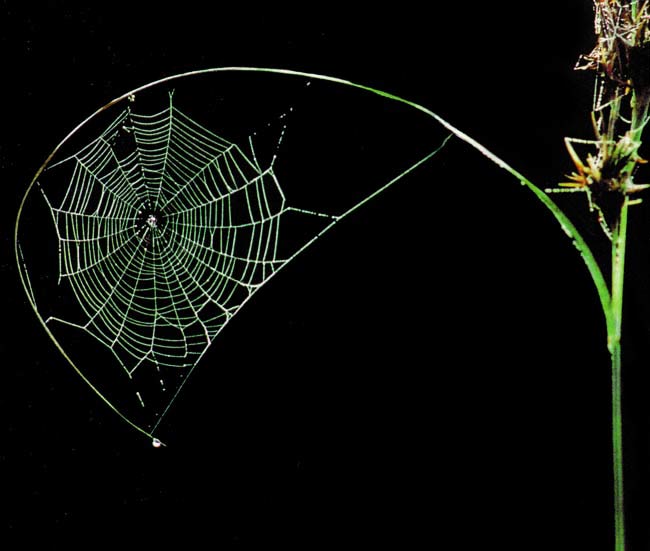

As well as their qualities, such as strength and elasticity, and their practical benefits, spiders' webs are a wonder of architecture and engineering.
The spider web is made up of load-bearing frame threads and spiral capturing threads laid over these and coated with a sticky substance, as well as threads binding all the threads together. The spiral coated sticky threads are not completely tied to the scaffolding threads. In this way the more an insect caught in the web struggles, the more it gets stuck to the web. As the capturing threads stick all over the insect, they gradually lose their elasticity, both growing stronger and stiffening. In this way the insect is trapped and immobilised, and can be violently cut up. After this the prey, held by the unyielding scaffolding threads, like a wrapped-up, living food parcel, has no alternative but to wait for the spider to come and deal the final blow.
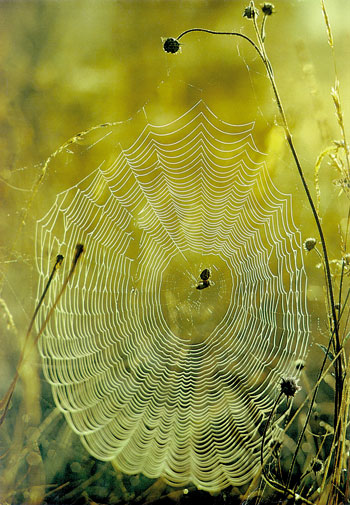 In order for spiders' webs to be an effective trap, it is not enough for them to be adhesive or to be made of threads with different characteristics. For example the web must be designed in such a way as to catch insects in flight. If we compare the insect caught in the web to a guided missile, just stopping the insect will not be sufficient. The prey caught in the web must be rendered immobile, so that the spider can come and examine and bite it. Catching a missile and immobilising it is no easy task.
In order for spiders' webs to be an effective trap, it is not enough for them to be adhesive or to be made of threads with different characteristics. For example the web must be designed in such a way as to catch insects in flight. If we compare the insect caught in the web to a guided missile, just stopping the insect will not be sufficient. The prey caught in the web must be rendered immobile, so that the spider can come and examine and bite it. Catching a missile and immobilising it is no easy task.
The threads which make up the web are at the same time both strong and elastic. But the level of elasticity of the web is different in different areas. This elasticity is important for these reasons:
- If the level of elasticity of the threads were less than required, an insect flying into the web would bounce back the way it had come, as if hitting a hard spring.
- If the elasticity of the threads were more than required, the insect would over-stretch the web, the sticky threads would adhere to each other and the web would lose its shape.
- The effect of the wind has also been allowed for in calculating the threads' elasticity. Thus a web stretched by the wind can resume its previous form.
- The level of elasticity is also important in relation to what the web is attached to. For instance, if it is attached to a plant, the elasticity has to be able to absorb any movement caused by the plant.
The spiral woven capturing threads lie very close to one another. The smallest swing could stick the capturing threads to each other, opening wide gaps in the trapping field. That is why the high-elasticity, sticky capturing threads are laid over dry, low-elasticity threads. This is a precaution against potential escape holes being formed.
As we have seen, a miraculous structure can be observed in every feature of the web. Every possibility has been thought of. This reveals once more the senselessness of the theory of evolution. It is, of course, impossible for changes which came about by coincidence to teach a spider to make the shock-absorbing properties of the web. It is God Who gave the spider this capacity, Who enabled it to display purposeful behaviour.
He is God – the Creator, the Maker, the Giver of Form. To Him belong the Most Beautiful Names. Everything in the heavens and earth glorifies Him. He is the Almighty, the All-Wise. (Surat al-Hashr: 24)

Three-dimensional webs have a much more complicated structure than two-dimensional ones. These webs are complicated three-dimensional structures, as opposed to being in just one plane. This type of web resembles a pile of woollen balls. For this reason it is harder to manage than the two-dimensional one. If small insects and parasites that are not worth the spider's bother get caught in the web, then the spider has more work to do. For this reason the spider chooses to make its web in places where there are no visitors of this kind.
One spider which uses this kind of web is the Black Widow. Inside the web of this spider, with its architectural mastery, there is also a mechanical trap. This trap forms a dense and sticky area. This web ball is tied to the ground with not particularly strong threads. As soon as a moving creature gets stuck to the web ball, the threads break, and the ball comes free of the ground. Shortly afterwards, the spider pulls the trap up, right into the three-dimensional web, and kills its motionless prey.
We must carefully examine the plan of the three-dimensional trap and the method employed by the spider, because there is clearly intelligence in the planning of the web. With or without a mechanical trap, the same method is used in three-dimensional webs to slow down the prey in its flight. These are specially woven in the framework of a plan with a large number of weak threads. Once the insect gets caught up, these weak threads snap. At that point, because the insect's movement energy goes into snapping the threads, its speed is reduced. Then the capturing threads catch the writhing insect.
Of course the spider did not learn all by itself to spin this web—which works according to a flawless plan—after a so-called period of evolution. Like other living creatures, spiders follow God's command. God, the Compassionate and Merciful has announced this in the holy verse "…everything in the heavens and earth, willingly or unwillingly, submits to Him and to Him they will be returned." (Surat Ali 'Imran: 83)
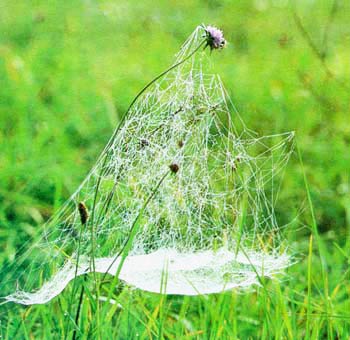 Linyphia spiders spin webs in the form of hammocks (the white area at bottom). The web is attached to plants by threads at the top and bottom. Insects which get caught on the threads at the top, fall inside. (Top) Some three-dimensional webs have a dome-like construction. The spider can definitely identify even a small insect caught in this complicated construction by the vibrations it gives off. 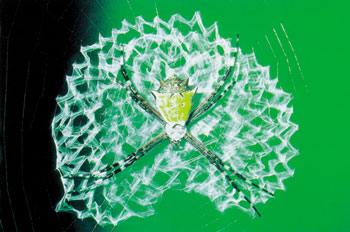 | 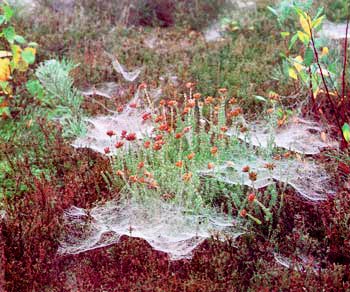  |
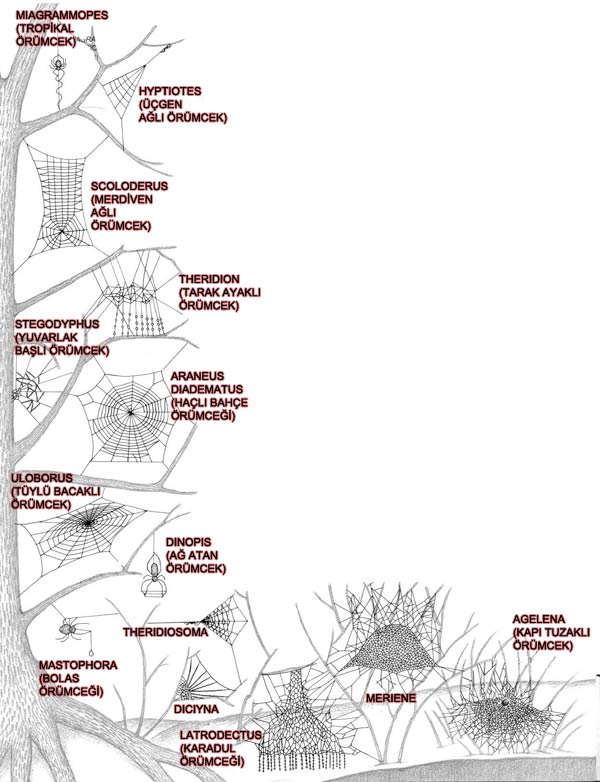
1. Miagrammopes:Tropical Stick Spider
2. Hytiotes: Triangle Spider
3. Scoloderus: (Ladder-Web Spider)
4. Therdion: (Comb-Footed Spider)
5. Stegodyphus: (Round-Headed Spider)
6. Araneus Diadematus: (Garden Cross Spider)
7. Uloborus: (Feather Legged Spider)
8. Dinopis: (Ogre-Faced Spider)
9. Mastophora: (Bolas Spider)
10. Theridiosoma: (Ray Spider)
11.Dictyna: (Mesh-Web Spider)
12. Neriene: (Filmy Dome Spider)
13. Agelena: (Funnel-Web Spider)
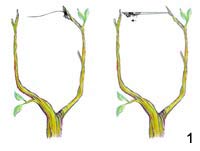 | 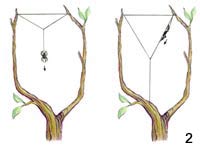 |
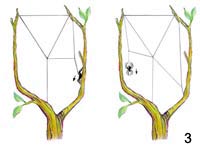 | 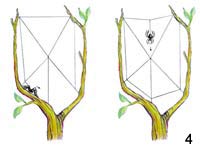 |
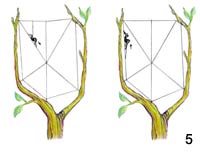 | 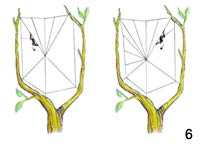 |
 | 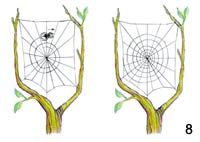 |

The spiders put designs like zig zags on the tops of their webs to prevent birds tearing them.
Spiders' webs need constant management, because the spiral sticky part may be damaged by rain or by prey struggling to escape. Furthermore, dust sticking to the web may destroy the stickiness of the spiral threads.
A web may, depending on where it is, lose the properties which enable it to catch insects in a very short time – 24 hours even. For this reason the web is periodically torn down and re-built. The spider eats and digests the threads of the web it is tearing down. It will use the amino acids in the threads it digests to build a new web.31
That part of the web which is eaten, and the time, differs according to the species of spider. Garden spiders, for example, do not touch the frame of the web, but just eat the radius of the web and the sticky spirals.
Tropical spiders construct their webs in darkness and eat them at dawn. Spiders in temperate regions eat their webs at night and build new ones for the day, because in these regions there are not as many night insects as there are in tropical regions. For this reason it is essential for the webs to be up throughout the day.
Spiders weave their webs to suit the size of the creatures they wish to hunt. The South American spider, for example, weaves a web with narrow openings that enable more easily to catch the white ants which come out to seek new nests in September. When it wants to hunt an insect such as a large butterfly it widens the openings and increases the web's strength and elasticity.
The angle of webs is also changed depending on the sort of prey that is expected to be caught (flying, walking, crawling, etc.). This both lessens damage and increases the trapping capacity.
Spiders tend to build their webs, which are so valuable to them, in quiet places. The reason for this is to prevent them being destroyed by animals or natural conditions. Spiders use most interesting methods to protect their webs. One of the most interesting of these is to be seen in the web of the Central American Argiope spider. These spiders place shiny white zig-zag markings on their webs. These markings are warnings to birds, reminding them not to venture inside the web. The spiders also use these markings to hide behind. The spider waits behind these markings and in this way prevents the prey from seeing it.
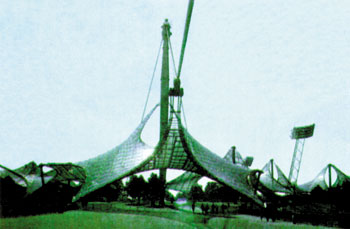
The roof of the Munich Olympic Stadium was inspired by spider webs. In this way the various tensions are evenly distributed over the roof.
Nowadays one very popular method of making industrial plans is to use examples from nature. That is because models in nature are flawless in every way. Inter alia, energy-saving properties, aesthetic qualities, flawless practicality, and the manoeuvrability essential to a plan already exist in perfect form in nature. Models which man produces with his own capabilities and the knowledge gleaned over long years and as a result of difficult processes, do not generally go beyond being poor imitations of their counterparts in nature. This can be easily seen when we compare these imitations with nature's originals.
Spiders are one of the living creatures taken as an example. For instance, the web of the crested, or dew spider is quite perfect from the aesthetic and engineering point of view. These spiders make their webs at a horizontal angle, in such a way as to make them resemble a sheet, on meadow grasses. Using upright blades as load-bearers, they distribute the overall weight of the web.
Man has copied this method in order to cover large areas. The Munich Olympic Stadium and Jeddah Airport terminal, often quoted as examples of modern architecture, were built using these spiders' webs as an example.
Spiders have been using these models, which man has produced by imitation, all over the world since they first emerged. Of course a fair degree of engineering knowledge is needed for such models to emerge and to be put into practice. But spiders know nothing about either construction engineering or architectural planning, having received no such training. They, like other living creatures, behave only in accordance with the inspiration given to them from birth by God. This is the only cause of their architectural wonders. God reveals in a verse that all living creatures are under His control.
That is God, your Lord. There is no god but Him, the Creator of everything. So worship Him. He is responsible for everything. (Surat al-An'am: 102)
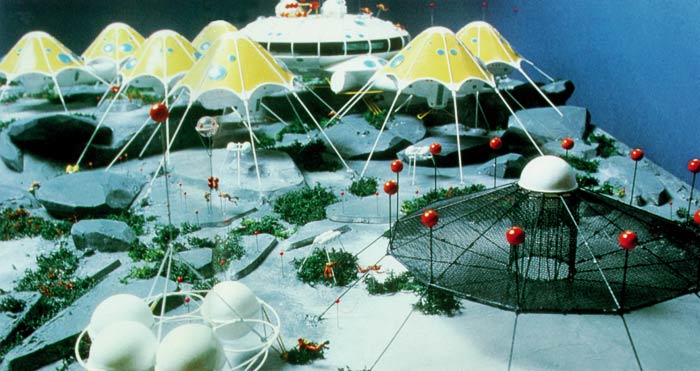
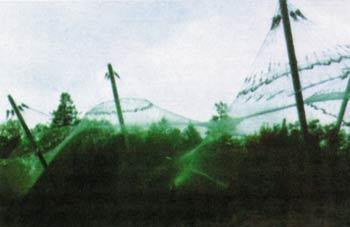
An underwater village project inspired by the web of the freshwater spider. For its survival the spider carries the necessary air and food into its waterproof web. In the underwater houses, glass is designed to be used instead of the web. (left) Bell-shaped bird cages in Munich, inspired by the technique employed by the raft spider in building its web (top).